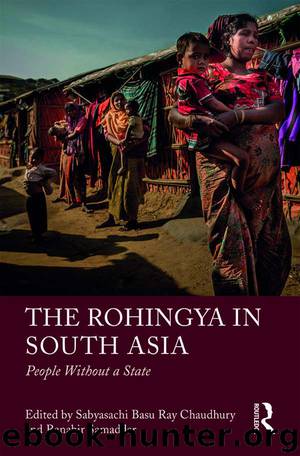The Rohingya in South Asia by Sabyasachi Basu Ray Chaudhury Ranabir Samaddar & Ranabir Samaddar

Author:Sabyasachi Basu Ray Chaudhury,Ranabir Samaddar & Ranabir Samaddar
Language: eng
Format: epub
Publisher: Taylor & Francis (CAM)
Escaping confinement?
The tragic irony of the Rohingya in Bengal is that they end up incarcerated in a place they believed would free them from the confinement of the ‘open prison’ of Myanmar and the camps of Bangladesh. The United States, however, believes the ‘real solution’ to the Rohingya refugee issue lies in their going back to Myanmar when the situation changes in Rakhine State. Assistant Secretary of State of the Department of Population, Refugees and Migration Anne Richard has said, ‘International pressure could play a part in changing that situation. The real solution for most Rohingya is that we should strive for this that they go home.’11
Myanmar has halted a national pilot project to verify the citizenship status of Muslim minorities in western Rakhine State. ‘The Rakhine situation is too complicated. The verification process is difficult since applicants are applying [for] an identity which does not exist in the country,’ said Rakhine Chief Minister Maung Maung in February 2015. This was a reiteration of the government’s position that the Rohingya were illegal migrants from Bangladesh. Officials have said the verification process was being conducted under a 1982 law that bars citizenship registration using the term Rohingya instead of Bengali.
Shwe Maung, a Muslim MP from the western part of Rakhine, says there may be a way around the problem. ‘I want to point out we should look at the generation of those who hold temporary citizenship cards,’ he said. ‘The problem will be solved in the short term if those who hold [temporary] citizenship cards and whose parents hold [temporary] citizenship cards are allowed to apply for citizenship [using] normal procedures, instead of a specific project.’12
Aiming to deal with the Rohingya crisis, the Commonwealth Human Rights Initiative in collaboration with the UNHCR organized a one-day training programme for officers of correctional homes in West Bengal on ‘Human Rights and Refugee Protection’ on 5 December 2014. The training was aimed at facilitating discussions and initiating a dialogue between them, the inmates of the homes and the UNHCR. Such discussion was aimed at enhancing coordination between prison administration and the UNHCR to enable seamless flow and exchange of information, thereby expediting the release of asylum-seekers in detention. The training focused on sensitization to the persecution of Rohingya in Myanmar; imparting appropriate knowledge about displaced people, asylum law and international principles; timely identification of asylum-seekers in detention through various identification tests relating to language, religion, education, occupation and so forth; creating a formal channel to direct the flow of asylum-seekers to the UNHCR; and India’s position on asylum-seekers and refugees and the UNHCR’s operational procedures in India.
Communication is a huge problem and language is only one part of it. The Rohingya cannot tell people about their history, which undermines their case for asylum. They either don’t understand how the process works or are advised to share as little as possible. Involvement of NGOs can improve the situation somewhat. Although RCFI has provided some help to the Rohingya in Delhi, it is completely unaware about their problems in correctional homes in Bengal.
Download
This site does not store any files on its server. We only index and link to content provided by other sites. Please contact the content providers to delete copyright contents if any and email us, we'll remove relevant links or contents immediately.
| Africa | Americas |
| Arctic & Antarctica | Asia |
| Australia & Oceania | Europe |
| Middle East | Russia |
| United States | World |
| Ancient Civilizations | Military |
| Historical Study & Educational Resources |
The Sympathizer by Viet Thanh Nguyen(4262)
The Rape of Nanking by Iris Chang(4103)
World without end by Ken Follett(3397)
Ants Among Elephants by Sujatha Gidla(3362)
Blood and Sand by Alex Von Tunzelmann(3101)
Japanese Design by Patricia J. Graham(3080)
City of Djinns: a year in Delhi by William Dalrymple(2489)
The Queen of Nothing by Holly Black(2436)
Foreign Devils on the Silk Road: The Search for the Lost Treasures of Central Asia by Peter Hopkirk(2407)
Inglorious Empire by Shashi Tharoor(2375)
India's Ancient Past by R.S. Sharma(2367)
Tokyo by Rob Goss(2346)
In Order to Live: A North Korean Girl's Journey to Freedom by Yeonmi Park(2317)
Tokyo Geek's Guide: Manga, Anime, Gaming, Cosplay, Toys, Idols & More - The Ultimate Guide to Japan's Otaku Culture by Simone Gianni(2291)
India's biggest cover-up by Dhar Anuj(2283)
The Great Game: On Secret Service in High Asia by Peter Hopkirk(2259)
Goodbye Madame Butterfly(2178)
Batik by Rudolf Smend(2052)
Living Silence in Burma by Christina Fink(2014)
